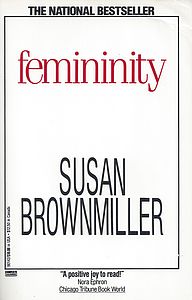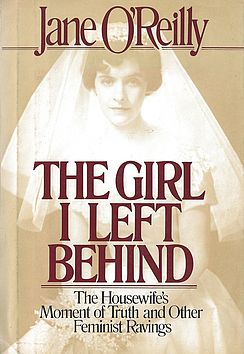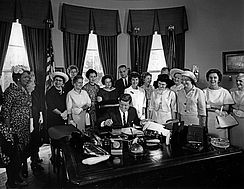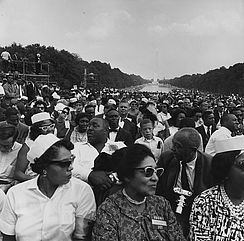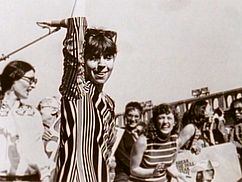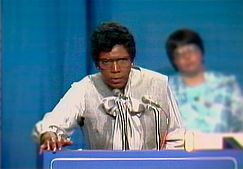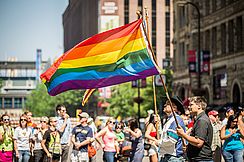Body & Health
Women’s Bodies: A Short Introduction
Who defines what is beautiful? What is the media’s role?
Excerpt from “Cover Girl Culture: Awakening the Media Generation,” a film by Nicole Clark. (Running time 12:16) Used with permission. The complete film is available from Zen Pen Films. More resources are available in Nicole Clark's Clever Girl Workshops.
Have you ever noticed how many issues associated with modern feminism relate to women’s bodies? Reproductive rights. The sexualization of popular culture. Domestic violence. Anti-pornography. Queer, lesbian, and transgender bodies. Women’s health and disabilities. Even female athletes. All roads lead back to the body.
If we are going to talk about women’s bodies, maybe we need to define our terms. Of course to most people it is perfectly obvious what a woman is: either what you are (if you’re female) or what you aren’t (if you’re male). And at the core of that difference is biology. What could be simpler?
As it turns out, the question of what is a woman — and, by extension, a woman’s body — is neither simple nor unchanging. To mimic Facebook’s relationship status, it’s complicated.
One of the most important contributions of recent scholarship in feminist theory and related fields is the concept that categories that most people think of as fixed and unchanging are in fact shaped by social and cultural norms. Thus, the category of woman turns out to be determined as much by society as by biology. For one thing, the idea that biology provides unambiguous differentiation between the sexes isn’t anywhere as clear a guide as generally thought. And the history of western cultures shows us that there have been very different notions of “woman” over time.
From antiquity through the late 1700s, a one-sex model prevailed, with the female body being seen as a lesser version of the male. For example, reproductive organs were understood as basically the same, but men’s were on the outside, and women’s on the inside. By the late eighteenth century that older view was increasingly being replaced by a two-sex model that divided the world into male and female categories now seen in opposition to each other; difference, rather than sameness, reigned. Note another outcome of this historical shift: Women’s bodies were generally viewed as more problematic and unstable, that is, all kinds of things happened to them and were ascribed to them that didn’t happen to men. This insight is especially important as we delve deeper into the questions of women’s health and sexuality.
Perfect measurements? Is a woman an object to be measured or a person to be valued?
Excerpt from "Miss America," a film by Lisa Ades. (Running time 1:29) Used with permission. The complete film is available from Women Make Movies.
The ideal female body type has also changed dramatically over the centuries, from the plumpness of the seventeenth-century model (voluptuous women are called Rubenesque for a reason) to the hourglass figure enforced by nineteenth-century corsets to the 1920s flapper silhouette to today’s painfully thin but full-breasted models. For decades the Miss America pageant sought to define an ideal female body — white, of course. All these ideal types of women’s bodies are rooted in a specific time and place.
Women’s bodies are also something on which laws are inscribed. Sumptuary laws in Puritan times dictated what clothing women could wear (not too ostentatious, please), and slave codes defined the actual items worn by enslaved women. Laws determined how much flesh women could show in public, as Annette Kellerman found out when she stepped onto a beach in 1907 in a one-piece bathing suit and was promptly arrested. Other laws regulated whether women could inherit property, practice birth control, serve on juries, be drafted, and a host of other activities.
One of the longest-standing prohibitions was against physical activity. Organized sports were seen as especially problematic for women, whose supposedly delicate bodies (especially their tender reproductive systems) were seen as unable to withstand the rigors of a game of baseball or basketball, particularly while menstruating. Never mind the hard physical labor women did in their homes and on their farms for most of recorded history. This raises the question whether the prohibitions against organized sports for women were truly designed to protect them. Were they? Or were they meant to ensure that women believed they were the weaker sex, or that a woman could not be an athlete and be feminine, or were they really intended to keep organized sports for men only?

Women’s bodies are also at risk of gender-based violence. Think of the terrible personal and social costs of such acts as rape, the sexual abuse of girls, and domestic violence and spousal abuse. Women face sexual harassment on the job, and lesbian couples can encounter sexual harassment or abuse just by walking down the street holding hands. International crimes such as female genital mutilation, honor killings, sex trafficking, and the use of rape as an instrument of war are all rooted in sustaining men’s power over women’s bodies.
Women’s bodies are also sexual bodies, and with sexuality comes both pleasure and danger. Probably no aspect of women’s bodies has been as contested as their sexuality, including the question of whether women had any sexual feelings to begin with. In the middle ages, a female orgasm was thought necessary to conception. Women’s sexual drives seemingly went missing in the eighteenth and nineteenth centuries, when the dominant cultural ideal morphed into portraying women as passionless or asexual beings. Women’s sexual selves were miraculously rediscovered in the twentieth century. Today the very notion of sexuality is rapidly expanding — think of the LGBTQ rainbow. Sexuality is a prime example of a socially constructed category.
For most of history, women lacked any real knowledge of their bodies and the workings of their reproductive systems. This wasn’t just a question of medicine and science being slow to map the terrain; rather, it was that women weren’t encouraged to learn and use what knowledge there was. One result was what Gloria Steinem referred to as the “down there” generations — women who lacked even the simplest vocabulary to describe their own genitalia. Eve Ensler’s ingenious creation The Vagina Monologues addressed that silence, as did the women’s health movement in the 1970s and beyond.
Women’s understanding of themselves as sexual beings is affected by broader developments in culture and society. A woman would have to be living in a cave without access to television or the Internet not to be bombarded by the relentless sexual messages from popular culture. Men are affected by these images too, but the images have an especially pernicious impact on women’s already fraught relationship with their bodies. Magazines feature airbrushed images of women’s bodies and faces to sell a variety of products – cars, beer, underwear, life insurance. Pornographic images graphically depicting the sexual exploitation of women are rarely more than a few clicks away on the Internet, and video games are often particularly misogynist when it comes to butchering female characters. The film industry includes far more examples of nudity, generally female, than ever before, and television is beginning to follow suit. Even when clothed, female characters are often clad in form-fitting, revealing outfits that show off whatever female body parts — breasts, legs, butts — are currently in vogue.
While adolescent girls have always worried about their looks, their weight, and their popularity, historian Joan Jacobs Brumberg notes that “girls today make the body into an all-consuming project in ways young women of the past did not.” The female body is to be managed and maintained, which in these days of social media is practically a full-time job. Because bodies, especially adolescent ones, are in fact not always so easy to police, girls grow up feeling anxious and insecure about their bodies, and by extension, about themselves. And popular culture is a prime culprit in feeding that insecurity.
Young girls are so vulnerable to these messages partly because they are maturing earlier than ever before, which means they are more susceptible to the messages from popular culture at a younger age. In the United States around 1900, the average age of menarche (first menstruation) was fourteen, and sexual activity did not usually occur until marriage. Now the average age of menarche is 12 and many young girls are sexually active by their mid-teens. To put it another way, they are already having sex at a time when their great-great-grandmothers still hadn’t gotten their periods.
Some of the most pernicious pressures concern body image and weight. Surrounded by images of rail-thin but incredibly buff Hollywood actresses and models, some with artificially created breasts, young girls absorb unrealistic expectations of what female bodies should look like. Dieting and exercise are deployed to emulate those bodies, contributing to the prevalence of anorexia and bulimia among adolescent girls (and a few men). Female athletes face special pressures to balance the musculature that is often necessary for athletic prowess with the feminine appearance that is dictated by cultural imperatives. The fact that any female athlete may feel that she has to conform to notions of feminine beauty shows the tyranny of these ideals. Tennis player Serena Williams provides a welcome counter-example of an athlete who proudly showcases her strong, muscular physique.
Besides the potential psychological damage of trying to keep up with these impossible body ideals and practices, to say nothing of the expense, many of these procedures are actually painful. Removing unwanted body hair by electrolysis hurts, especially to maintain the so-called bikini line needed to wear a bathing suit without pubic hair peeking out. So does piercing, which used to be limited to pierced ears but now extends to a range of body parts, including nipples, noses, and genitalia. Tattoos previously limited to sailors and exotic circus performers are now sported by a wide cross-section of the population. Athletes talk about “no pain, no gain,” but these bodily interventions take that adage to a new level.
It is not just young girls who get caught up in the “body project.” Many adult women, including aging baby boomers and more than a few older feminists, find it difficult to escape expectations of how they are supposed to look and dress and what they are supposed to weigh. When Gloria Steinem was complimented on her youthful appearance mid-career, she quipped, “This is what forty looks like,” but not all women can manage such a confident retort. The double standard of aging complicates things: gray hair connotes stature and wisdom for male actors and television anchors, but there is no equivalent for women, who feel compelled to hide the gray in order to hold on to a semblance of their youthful appearance. In the 1950s an advertisement for Miss Clairol hair dye, then used by only 7 percent of the nation’s women, asked “Does she or doesn’t she? Only her hairdresser knows for sure.” Today, the answer is “she does.”
Attacking the media’s promotion of unrealistic or demeaning images of women has been a top priority of the women’s movement since the 1960s. One of the most popular and effective features of Ms. Magazine, which debuted in 1972, was a section called “No Comment” that reprinted particularly sexist and offensive ads, with readers encouraged to contact the companies to voice their disgust. They got results. Books such as Susan Brownmiller’s Femininity (1984) and Naomi Wolf’s The Beauty Myth (1991) critiqued the media’s portrayal of women and the beauty industry from a feminist perspective. Jean Kilbourne’s documentary series, Killing Us Softly, which first aired in 1979, dissected advertising’s demeaning and often violent imagery. But the fight has been an uphill battle.
Barring the onset of a new era of prudery and restraint, what can girls and women do in response to the pervasive sexualization of popular culture? Feminists say: Be aware of who is pitching these messages and who stands to gain (i.e., make money) from them; make choices based on what you want, not what you are told to consume. Create counter-images, especially of what real women’s bodies look like — lumpy, slim, sagging, taut, pear-shaped, or twiggy — and demand that the media and advertisers recognize and market to real women, not just airbrushed ones. And be skeptical, very skeptical, of images that look too flawless to be true — because they probably are. “What if every woman in America woke up tomorrow,” historian Susan Douglas asks, “and simply decided that she was happy with the way she looked?” Now that’s a body project worth buying in to.
How to Navigate our Interactive Timeline
You will find unique content in each chapter’s timeline.
Place the cursor over the timeline to scroll up and down within the timeline itself. If you place the cursor anywhere else on the page, you can scroll up and down in the whole page – but the timeline won’t scroll.
To see what’s in the timeline beyond the top or bottom of the window, use the white “dragger” located on the right edge of the timeline. (It looks like a small white disk with an up-arrow and a down-arrow attached to it.) If you click on the dragger, you can move the whole timeline up or down, so you can see more of it. If the dragger won’t move any further, then you’ve reached one end of the timeline.
Click on one of the timeline entries and it will display a short description of the subject. It may also include an image, a video, or a link to more information within our website or on another website.
Our timelines are also available in our Resource Library in non-interactive format.
Timeline Legend
Yellow bars mark entries that appear in every chapter
This icon indicates a book
This icon indicates a film
1971 The Click! Moment
The idea of the “Click! moment” was coined by Jane O’Reilly. “The women in the group looked at her, looked at each other, and ... click! A moment of truth. The shock of recognition. Instant sisterhood... Those clicks are coming faster and faster. They were nearly audible last summer, which was a very angry summer for American women. Not redneck-angry from screaming because we are so frustrated and unfulfilled-angry, but clicking-things-into-place-angry, because we have suddenly and shockingly perceived the basic disorder in what has been believed to be the natural order of things.” Article, “The Housewife's Moment of Truth,” published in the first issue of Ms. Magazine and in New York Magazine. Republished in The Girl I Left Behind, by Jane O'Reilly (Macmillan, 1980). Jane O'Reilly papers, Schlesinger Library.























